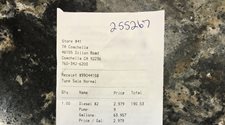Receipts have many functions within our business. Receipts back up our logs of where we said we were. Receipts help us to know how are business is doing and what we need to do to fine tune our expenses. Keeping track of receipts can be as hard as we make it.
 For those who do not want to do their own bookkeeping all receipts can be placed in an envelope and sent off to a business partner like ATBS. ATBS will take the receipts enter them into the computer and send out a profit and loss statement for you to look over. This works great for those that do not enjoy bookkeeping as you basically get to have your cake and not make it! Looking over the P & L though is a must to keeping the business on an even keel.
For those who do not want to do their own bookkeeping all receipts can be placed in an envelope and sent off to a business partner like ATBS. ATBS will take the receipts enter them into the computer and send out a profit and loss statement for you to look over. This works great for those that do not enjoy bookkeeping as you basically get to have your cake and not make it! Looking over the P & L though is a must to keeping the business on an even keel.
For those of us that like to keep track of our own receipts it can be a little more time consuming and it is very important that we stay organized. I use the same concept of the envelopes to keep track of receipts. There is a little more to the process though.
Create the Receipt – Buy Something
Record the Receipt
Place Receipt in Envelope
Scan the Receipt
File Receipt
When home take receipts and file in permanent file that is well marked for end of year IRS filing.
This process can be fine-tuned to each of our needs. As you might imagine I go a little further for several reasons. I hate to search for receipts and when away from home where I cannot search though the actual receipt I needed a better system to find the scanned receipt. First I created a file system on my computer for each year. Then I added files for each of the categories that I have found works for me to find my scanned receipts. These files match my files at home.
Now for the actual receipt as we pay using our Discover Card, our bank card, and cash so this can make it tricky to trace the original payment. We also use Comdata to purchase our fuel and that is another important receipt to track. What I have found helps me is to number each receipt. First I use a D for Discover or C for cash and nothing for our debit card. Next comes the year and the next number in chronological order. Not everything entered in the register creates a receipt and those are not numbered. I number the fuel receipts with the odometer reading. When I scan the receipts for example it will say the receipt number D1704 and then the business such as Blue Beacon. This makes the receipt very easy to find!
On the first of each month I create a P & L sheet. Since I use Quicken I have to track our fuel mileage on a spread sheet. I use our starting and ending odometer reading for the month to know how many miles we drove. This will give me our expenses per mile and also our profit per mile that is written on the P & L created in Quicken. Interesting reading for sure over the years looking at how our costs have changed.
On a side note keep track of the miles used on your personal vehicle that is also used for business. Our pickup is used for personal use as well as for business. We keep a note book in the pickup and when we are going somewhere to pick up parts, doctor, or anything related to business we write in the date, mileage, and what we were getting so if questioned I can find the corresponding receipt quickly.
At the end of the year everything is grouped where I need it to fill out my worksheet for our accountant.